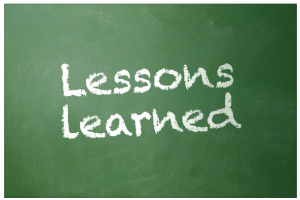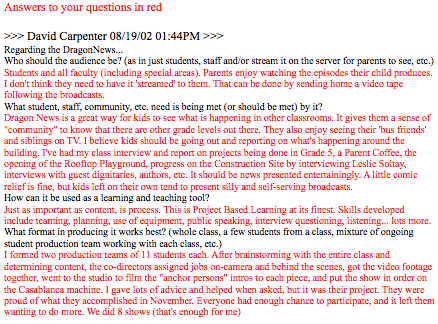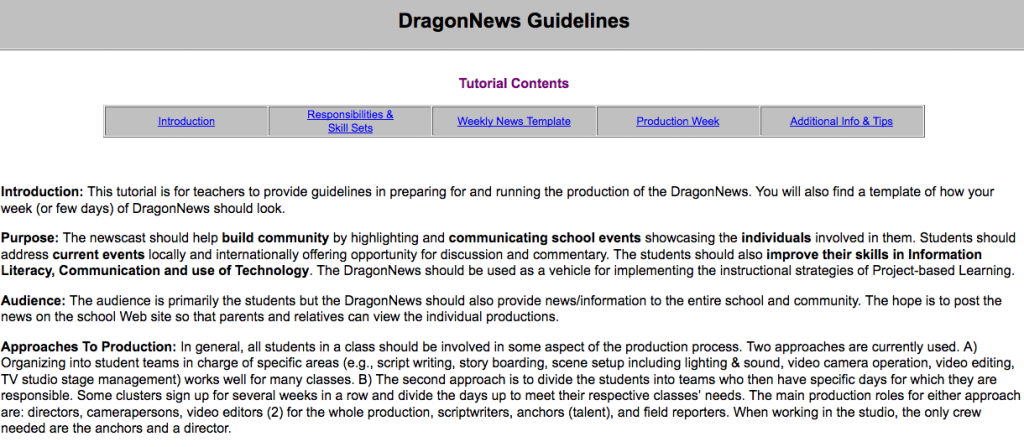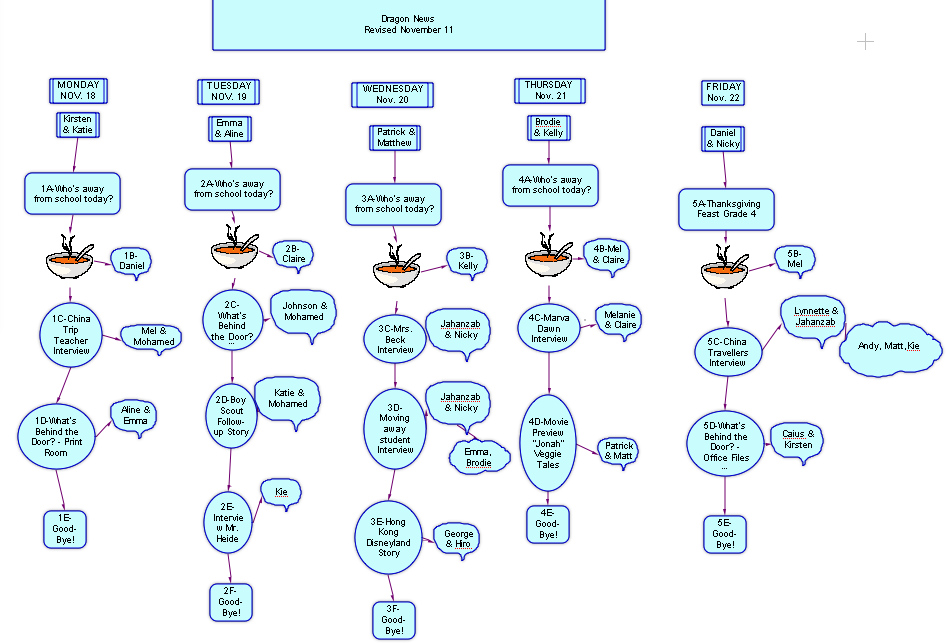
I am reviewing past posts, articles, and podcasts to share my main lessons learned. Here are a few lessons learned from supporting students to create news shows.
______________________
After graduate school in the US, my wife and I returned to international education in 2002. My plan upon arriving at the Upper Primary of the Hong Kong International School was to start a student-produced news show. An essential part of my instructional technology program focused on videography.
My plans changed when I discovered that the school had a TV production studio, a closed circuit TV system with TVs in all the classrooms, and two costly Sony 3 CCD cameras. 🙂
While the infrastructure wowed me, I learned that the school community was not watching the student news shows for the most part. Students, in many cases, were given free rein to record whatever they wished to share as a news program. Silly was the main descriptor offered by several teachers. 🙁
From this starting point, I put together a plan of action which leads me now in reflection to share the following lessons learned. Student-produced news has become mainstream in many of our schools today, so what follows might be old news for some veterans, but hopefully, it can offer some ideas about whether you want to assess your current news program or if you want to start one.
Lessons Learned:
- Look to make a needs assessment and information-gathering effort to get buy-in and insights and to promote the value of student-produced news. There are many other tools one can use today to do this task. The screen capture below is an example of an email questionnaire I sent out to teachers.

-
- Build the case for student news shows as a terrific example of project-based learning that puts students in the authentic roles of news gathers, logistics coordinators, editors, designers, etc.
- There are many ways to organize students into teams to produce the news. The one we used was by classroom with teachers looking out to the upcoming year and reserving their week to present the news each morning. Classes would spend the week before their assigned week doing all the production work so their videos could be shown the following week. This made the entire process less stressful.
- I titled this post “Student-CENTERED” because there might be a tendency in some schools to have an adult run the production process, including doing the video editing. This raises the question of why one is doing student-created news shows. If it is really about the learning process and not as much about the final product, students should run the entire process supported with lots of scaffolding and guidance when needed. When students are given complete ownership over a creative project, especially one that involves sharing a final product, they will want to shine in front of their peers.
- Try to get the classroom teacher to take ownership of being the adult facilitating the process. In many schools, the instructional technologist, librarian, or other specialist is seen as the “news person,” and the students are handed over to them. A part of the teacher’s ownership is their work to connect the classroom curriculum to the news project. Think of all the habits of mind and dispositions that we work with our students to experience that the experiential nature of news production brings into play. Teamwork, active listening, problem-solving, etc., are so supported by videography and news creation. Another connection for teachers is to use news programs to communicate what learning takes place in their classroom.
- News shows are about building community while celebrating what students and teachers do. One of my favorite parts of seeing students produce their shows was after their planning meetings, students would venture out to find the news and set up appointments with adults for interviews. Talk about real-life experiences!
To help teachers get the hang of videography and news production, plan a small project a month or two before their reserved week of news. Work with a small group of students or the whole class to produce videos. This is so much easier today, with so many schools having mobile media devices like iPads. These opportunities offer the chance to start teaching the lessons the students and teachers need before they do their news gathering and production work. Planting videography “seeds” will open the door for teachers to see student-created videos as an assessment tool. The following is a screen capture of an Inspiration mind map I used in my lessons to teach the videography production process. Today I would supplement my lessons with online tutorials, and news shows samples for students and teachers who want a more blended approach.

- Taking on a news project can make some teachers uncomfortable, especially with the technology giving students so much control over the process. With this in mind, look to produce guidelines, sample news shows, and templates to scaffold the process for your teachers. The following is a screen capture of my guidelines for our “DragonNews” program. It was a part of the Teacher Toolkit website (now only at the Internet Archive), where I housed tutorials and resources for teachers. I copied the entire page of DragonNews guidelines and posted them to a Google Site if you want many more details.

- Another scaffolding tool is to provide templates. Here is a screen capture of a storyboard template populated by a Fourth Grade class with their plans. We used Inspiration a lot in those days as it was beneficial for storyboarding, with students being able to move topics around as they planned each day’s show. Today I would use a web-based tool so that the production team can access it 24/7.

- The organization is so vital to the production process. Notice in the image above how each symbol has a number and letter. Monday was “1” for example, and the letter designated the sequence of each scene. The camera team used a small whiteboard to write the day and scene to be recorded at the start of each shot. They also kept a log of each scene recording which one the video editors should use. With multiple takes, this made a difference for the editors. Also, notice the listing of student names. These were the assigned talent for each scene.
- Regarding editors, we have two in charge of editing for the entire week. I asked teachers to think about which students had an eye for design, solid spatial understanding, and a certain seriousness in wanting to do a good job. One of my big design lessons was to stress that the classes were producing their shows for an audience other than themselves which included adults and, obviously, their peers. We stressed the importance of content and not special effects to be recorded in a quality manner with good audio and lighting and the on-screen talent using their best communication skills.
Leave a Reply